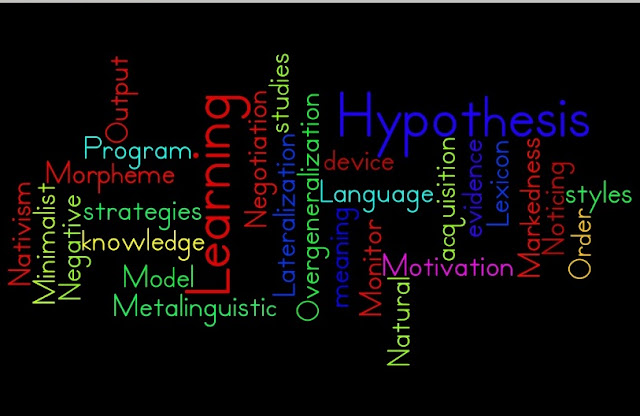Language acquisition device
A term used by Chomsky to describe the innate faculty for language acquisition
Lateralization
The process by which each hemisphere of the brain becomes specialized for different functions
Learning strategies
Techniques that learners consciously select to assist them in the achievement of their learning goals
Learning styles
Learners’ traits and preferences relating to the ways they perceive, process and remember information
Lexicon
The mental store of words that each learner has acquired
Markedness
A classification which describes the default, unmarked form in contrast to the less common, marked form in pairs of language features such as unvoiced and voiced consonants
Metalinguistic knowledge
Explicit conceptual knowledge about language
Minimalist Program
A development of Chomsky’s Principles and Parameters model that aims to account for the properties of language with maximum economy
Monitor Model
Krashen’s hypothesis that learners can consciously monitor and correct the output from their acquired language system
Morpheme studies
Studies of the order in which grammatical morphemes are acquired, which provide support for the belief in a natural order of acquisition independent of the influence of the learner’s L1
Motivation
The degree of desire to accomplish a goal, which partly determines the amount of effort one is willing to make to do so
Nativism
The theory that all humans are born with an innate capacity for language acquisition
Natural Order Hypothesis
The theory that the grammatical features of a language are acquired in a set sequence, independent of the learner’s first language
Negative evidence
Feedback on Learner L2 output indicating that there is a gap between the interlanguage form produced and the correct target language form
Negotiation of meaning
The collaborative use of comprehension checks and clarification requests to prevent or repair breakdown of communication
Noticing
Paying conscious attention to a feature of the L2 input
Output Hypothesis
The claim that the language produced by L2 learners plays a significant part in the process of acquisition
Overgeneralization
The application of a rule to cases where it should not be applied, such as erroneously adding –ED to form the past tense of an irregular verb
A term used by Chomsky to describe the innate faculty for language acquisition
Lateralization
The process by which each hemisphere of the brain becomes specialized for different functions
Learning strategies
Techniques that learners consciously select to assist them in the achievement of their learning goals
Learning styles
Learners’ traits and preferences relating to the ways they perceive, process and remember information
Lexicon
The mental store of words that each learner has acquired
Markedness
A classification which describes the default, unmarked form in contrast to the less common, marked form in pairs of language features such as unvoiced and voiced consonants
Metalinguistic knowledge
Explicit conceptual knowledge about language
Minimalist Program
A development of Chomsky’s Principles and Parameters model that aims to account for the properties of language with maximum economy
Monitor Model
Krashen’s hypothesis that learners can consciously monitor and correct the output from their acquired language system
Morpheme studies
Studies of the order in which grammatical morphemes are acquired, which provide support for the belief in a natural order of acquisition independent of the influence of the learner’s L1
Motivation
The degree of desire to accomplish a goal, which partly determines the amount of effort one is willing to make to do so
Nativism
The theory that all humans are born with an innate capacity for language acquisition
Natural Order Hypothesis
The theory that the grammatical features of a language are acquired in a set sequence, independent of the learner’s first language
Negative evidence
Feedback on Learner L2 output indicating that there is a gap between the interlanguage form produced and the correct target language form
Negotiation of meaning
The collaborative use of comprehension checks and clarification requests to prevent or repair breakdown of communication
Noticing
Paying conscious attention to a feature of the L2 input
Output Hypothesis
The claim that the language produced by L2 learners plays a significant part in the process of acquisition
Overgeneralization
The application of a rule to cases where it should not be applied, such as erroneously adding –ED to form the past tense of an irregular verb
Original definitions and selection of terms © 2013 Anglo-Hellenic Teacher Training
References
VanPatten, B. & Benati, A. (2010) Key Terms in Second Language Acquisition. London: Continuum.
VanPatten, B. & Williams, J. (eds.). (2007) Theories in Second Language Acquisition: An Introduction. London: Routledge
Doughty, C. and Long, M. (eds.) (2003) Handbook of second language acquisition (2nd edition) Oxford: Blackwell.
Mitchell, R., Myles, F. & Marsden, E. (eds.). (2012) Second Language Learning Theories (3rd Edition) London: Routledge
Saville-Troike, M. (2012) Introducing Second Language Acquisition (2nd edition) Cambridge: Cambridge University Press

No comments:
Post a Comment